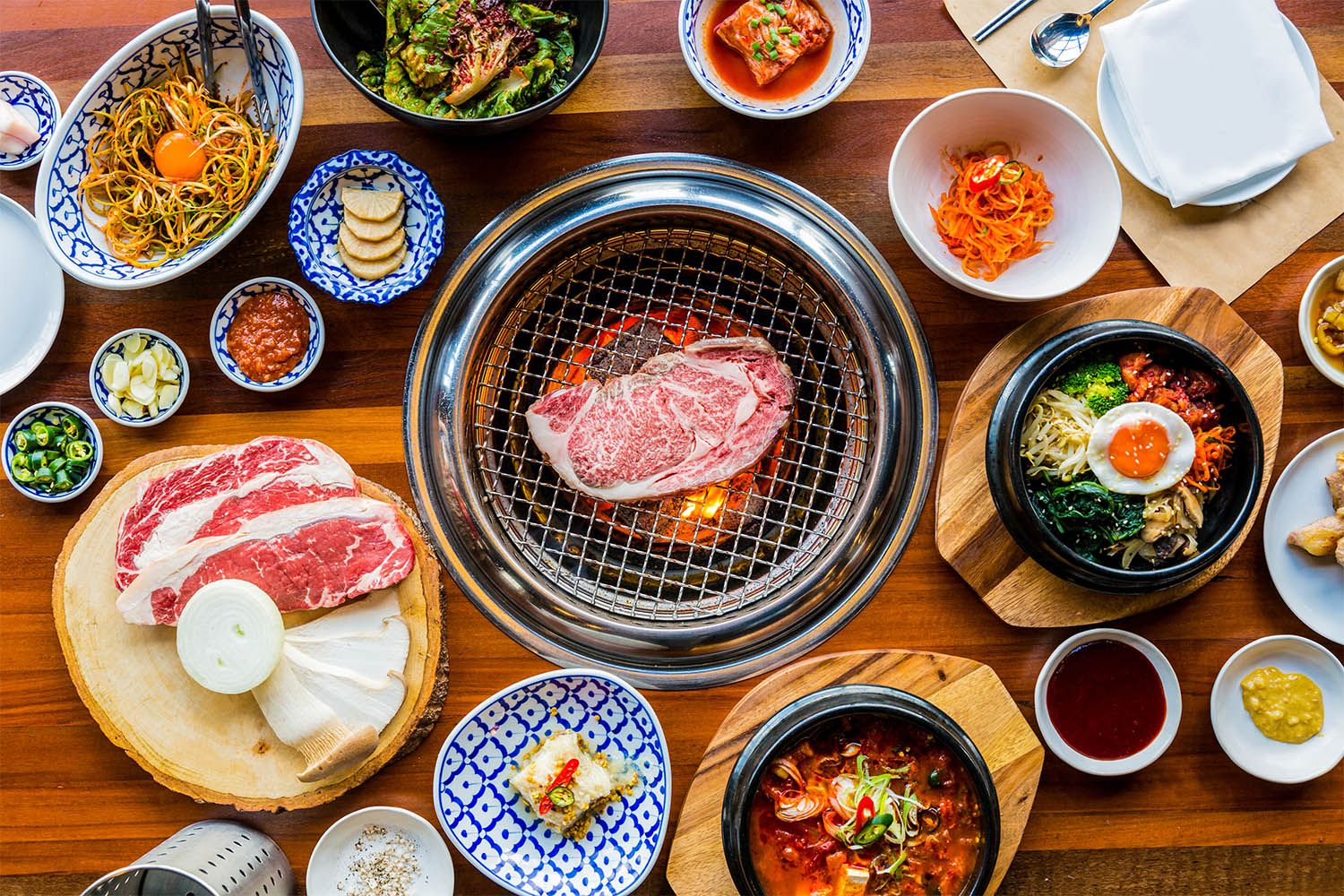8 Samgyupsal Side Dishes You Should Know About

For many Filipinos, samgyupsal (grilled pork belly) has become shorthand for all things Korean barbecue. Hence, the generous array of fixings served with each order is called “samgyupsal side dishes.” In Korea, these are called banchan, a term encompassing many categories of meal accompaniments. Diners partake of these communal dishes, along with a big pot of jjigae (Korean stew) and individual servings of rice.
Many Korean households keep an abundance of these sides stocked and ready to eat. Everyday meals are sometimes composed of only steamed rice and a couple of banchan. Each set is quite varied, so you can eat different combinations and achieve balanced meals with complex flavors every time.
General Types of Banchan
Here some of the common Korean side dishes based on their key ingredients and preparation methods:
Kimchi (Fermented)
Korea’s national dish features fermented vegetables seasoned with spices and salt. Locals enjoy kimchi with almost every meal.
Jangajji(Pickled)
Thisrefers to vegetables pickled in fermented condiments like soy sauce, doenjang (soybean paste), andgochujang(chili paste).
Namul muchim(Lightly seasoned)
Namul is milder in flavor compared to kimchi and jangajji. It covers vegetables, roots, and sprouts, lightly seasoned and sauteed, blanched, or steamed. Common seasonings include sesame oil, vinegar, and soy sauce.
Bokkeum(Sauteed or stir-fried)
Bokkeum is the umbrella term for sauteed or stir-fried ingredientscooked in oil and with ready-made sauces. It comes in dry and wet varieties.
Jorim(Braised or simmered)
This one’s all about braising or simmering ingredients in a seasoned broth or sauce. The usual flavorings include soy sauce, gochujang, and gochugaru(chili powder).
Jjim(Steamed or boiled)
Jjim is another name for steamed or boiled dishes thatgo beyond sides. Common examples include galbijjim (marinated short ribs) and tteok-bokki(simmered rice cakes).
Jeon(Pan-fried)
These are crispy, savory pancakes or fritters. They consist of meat, seafood, and veggies, pan-fried until golden brown.
These categories offer a broad picture of what's possible with banchan. Most families, eateries, and mom-and-pop marts will have their take on each dish. Some modern Korean restaurants even offer less traditional fare like gamja(potato) salad. As long as the flavors and textures in your assortment of sides are well-balanced, they should make for an exceptionally satisfying meal even without the samgyupsal.
8 Samgyupsal Side Dishes You Can Enjoy at Home
1. Kimchi
When most people think of kimchi, they think of baechu-kimchi, made with cabbage, typically napa. But other common ingredients used for this vegetable side dish include radish (for ggakdugi), scallion (for pa), and cucumber (for oi).
Since kimchi is integral to Korean food culture and identity, most households take pride in making their own. The kimchi-making process requires simple techniques like cutting, draining, and brining veggies in salt, spices, and fish paste. If all goes well, your kimchi should be ready in a few days at room temperature. For best results, continue the fermentation process in the fridge for 3-4 weeks.
2. Oi muchim
Oi muchim is a spicy cucumber salad seasoned with onions, garlic, soy sauce, gochugaru, sesame oil, and sugar. It’s slightly pungent, deeply savory, and refreshing. Prepare it right before serving so the cucumber maintains its crunchiness.
3. Kongnamul-muchim
Kongnamul-muchim is another simple side dish that can be made right before a meal. It features soybean sprouts lightly seasoned with the same flavorings as oi muchim. It uses less gochugaru to manage spice and adds roasted sesame oil for a nuttier flavor.
4.Pajeon
Pajeon is a pan-fried savory pancake that uses scallion (pa) as its main ingredient. To make a basic batter, combine eggs, wheat and rice flour, and water. Some recipes call for doenjang and sugar for added flavor. You can also use sparkling water for an extra crispy result. Other varietiesinclude haemul(seafood), gamja, and kimchi.
5.Eomuk bokkeum
Eomuk bokkeum refers to stir-fried fish cakes (eomuk or odeng). Some Korean street vendors sell boiled eomuk in skewers or tteok-bokki. This dish can be mild or spicy depending on the amount of gochujang and chili peppers. The chewy fish cakes are quite filling by themselves when enjoyed with rice.
6. Gamja salad
Gamja salad falls between a chunky, mayo-based potato salad and creamy mashed potatoes. And just like both dishes, it’s easy to make at home with pantry staples. You only need potatoes, Lady’s Choice Real Mayonnaise, chopped hard-boiled eggs, and rice syrup or sugar. To achieve a fluffy texture, use a fork or potato masher to combine your ingredients. This way, you can leave whole, bite-sized chunks of potato for rustic appeal. Bring it to the next level with cucumbers, carrots, raisins, apples, and onions.
7. Algamja-jorim
Algamja-jorim roughly translates to “braised baby potatoes.” They have a sticky, sweet-and-salty sauce, a crisp yet chewy exterior, and a soft, tender interior. Korean cookbook author Maangchi notes in her blog, “Well-made algamja-jorim can go for hours without getting soggy or losing their shine.” This makes them the perfect make-ahead dish for packed lunches.
8. Gyeran-mari
Gyeran-mari, or “rolled omelette,” is an egg dish with finely diced ingredients. It’s sliced into bite-sized pieces before serving, so the colorful veggies and meat can be better appreciated. You can make your own with any available ingredients, like carrots, green onions, and canned tuna. Like algamja-jorim, this omelette is great for packed lunches and as a satisfying ulam.
So, which banchan are you most excited to try recreating at home? These samgyupsal side dishes may be daunting to make all at once, so start with the simplest recipes –gamja salad or gyeran-mari. Eventually, you’ll be proficient enough in the artofKorean side dish recipes that you can move to more complex dishes.
Suggested Article

Japanese Natto: A Quick Guide
